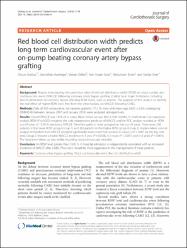Red blood cell distribution width predicts long term cardiovascular event after on-pump beating coronary artery bypass grafting

View/
Access
info:eu-repo/semantics/openAccessDate
2016Author
Gürbüz, OrçunKumtepe, Gencehan
Özkan, Hakan
Karal, İlker Hasan
Ercan, Abdulkadir
Ener, Serdar
Metadata
Show full item recordAbstract
Background: Reports investigating the predictive value of red cell distribution width (RDW) on major cardiac and cardiovascular event (MACCE) following coronary artery bypass grafting (CABG) have major limitations, including lack of elimination of common factors affecting RDW levels, such as anemia. The purpose of this study is to identify the real effect of higher RDW level, free from the other factors, on MACCE following CABG. Methods: Data of 500 consecutive, non-anemic patients (77.2 % male and mean age 63.05 +/- 9.24) undergoing ONBHCAB between January 2007 and January 2010, were analyzed retrospectively. Results: Overall MACCE was 7.8 % of all cases. Mean follow-up was 66.5 +/- 9.96 months. In multivariate Cox regression analysis, RDW (P = 0.022) remained the only independent predictor of MACCE and the ROC analyze revealed an RDW cut-off value of 13.95 % predicting MACCE. Therefore, patients were grouped on this cut-off value. There were 238 patients in the lower RDW group (Group 1) and 262 patients in the higher RDW group (Group 2). Kaplan-Meier survival analysis of freedom from MACCE revealed significantly lower event free survival in Group 2 (P < 0.001 by the log-rank test). Group 2 showed a higher MACCE incidence in 1 year (P = 0.030), in 3 years (P < 0.001) and in 6 years (P < 0.001). The long-term follow-up was similar regarding noncardiovascular mortality. Conclusion: An RDW level greater than 13.95 % in hospital admission is independently associated with an increased incidence of MACCE after CABG. Physicians should be more aggressive in the management of these patients.

















